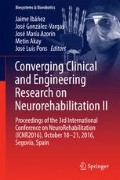Abstract
This paper presents the design of a compliant, lightweight and adaptable active ankle foot orthosis (AAFO) and two iterations of the conceptual design of an active knee actuator. The actuators are designed to keep their torque to weight as low as possible. The adaptability of the AAFO allows adjusting the device to different patients, without the need of customized versions. The knee actuators are designed for 2 exoskeleton prototypes that will be used for assistance of people with muscle weakness and for gait rehabilitation of incomplete spinal cord injury (iSCI) patients.
Access this chapter
Tax calculation will be finalised at checkout
Purchases are for personal use only
References
R. Alexander, Three uses of springs in legged locomotion. Int. J. Robot. Res. (Spec. Issue Legged Locomotion) 9(2), 53–61 (1990)
M. Moltedo et al., Mechanical design of a lightweight compliant and adaptable active ankle foot orthosis, in 6th IEEE International Conference on Biomedical Robotics and Biomechatronics 2016, submitted for publication
R. Van Ham et al., MACCEPA, the mechanically adjustable compliance and controllable equilibrium position actuator: design and implementation in a biped robot. Robot. Auton. Syst. 55(10), 761–768 (2007)
T. Bacek et al., Conceptual design of a novel variable stiffness actuator for use in lower limb exoskeletons, in IEEE International Conference on Rehabilitation Robotics, Singapore (2015), pp. 583–588
J. Perry, J.M. Burnfield, Gait analysis: normal and pathological function. J. Sports Sci. Med. 9(2), 353 (2010)
Acknowledgments
This work is supported by the European Commission’s 7th Framework Program as part of the project BioMot (Grant Agreement number IFP7-ICT-2013-10-611695), by the Flemish agency for Innovation by Science and Technology as part of the project MIRAD (IWT-SBO 120057) and by the FWO grant (no.G026214N).
Author information
Authors and Affiliations
Corresponding author
Editor information
Editors and Affiliations
Rights and permissions
Copyright information
© 2017 Springer International Publishing AG
About this paper
Cite this paper
Lefeber, D., Moltedo, M., Bacek, T., Langlois, K., Junius, K., Vanderborght, B. (2017). Compliant Lightweight Actuator Designs for Robotic Assistance and Rehabilitation Exoskeletons. In: Ibáñez, J., González-Vargas, J., Azorín, J., Akay, M., Pons, J. (eds) Converging Clinical and Engineering Research on Neurorehabilitation II. Biosystems & Biorobotics, vol 15. Springer, Cham. https://doi.org/10.1007/978-3-319-46669-9_226
Download citation
DOI: https://doi.org/10.1007/978-3-319-46669-9_226
Published:
Publisher Name: Springer, Cham
Print ISBN: 978-3-319-46668-2
Online ISBN: 978-3-319-46669-9
eBook Packages: EngineeringEngineering (R0)

